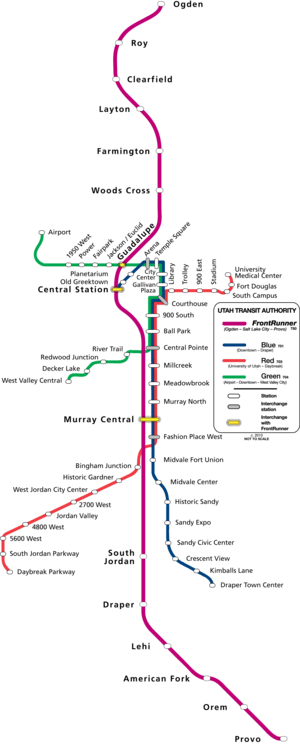TRAX (light rail)
Transit Express, or TRAX, is a light rail system in the Salt Lake Valley of Utah, in the United States, serving Salt Lake City and many of its suburbs throughout Salt Lake County. The official name of Transit Express [6] is rarely, if ever, used. The system is operated by the Utah Transit Authority (UTA). All TRAX trains are electric, receiving power from overhead wires.[7]
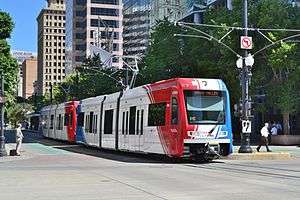 TRAX Green Line train at Gallivan Plaza | |||
| Overview | |||
|---|---|---|---|
| Owner | Utah Transit Authority (UTA) | ||
| Area served | Salt Lake Valley | ||
| Locale | Salt Lake County, Utah, U.S. | ||
| Transit type | Light rail | ||
| Number of lines | 3 | ||
| Number of stations | 50 | ||
| Daily ridership | 67,300[A 1] | ||
| Annual ridership | 19,704,300[A 1] | ||
| Headquarters | 3600 South 700 West South Salt Lake, Utah 84119-4122[1] | ||
| Website | rideuta.com | ||
| Operation | |||
| Began operation | December 4, 1999 | ||
| Operator(s) | UTA | ||
| Number of vehicles | 146 (total)[2]
| ||
| Technical | |||
| System length | 44.8 mi (72.1 km)[5] | ||
| Track gauge | 4 ft 8 1⁄2 in (1,435 mm) standard gauge | ||
| Electrification | 750 V DC, Overhead lines | ||
| |||
| Average weekday boardings |
Annual percent change |
Reference & notes | |
|---|---|---|---|
| 1999 | 8,600 | - - | [A 2] |
| 2000 | 19,100 | N/A | [A 3] [Note 1] |
| 2001 | 21,300 | -2.37% | [A 4] [Note 2] |
| 2002 | 31,400 | 70.41% | [A 5] |
| 2003 | 38,000 | -1.14% | [A 6] [Note 3] |
| 2004 | 39,100 | 13.80% | [A 7] |
| 2005 | 53,400 | 13.25% | [A 8] |
| 2006 | 49,700 | 14.15% | [A 9] |
| 2007 | 39,700 | -16.26% | [A 10] |
| 2008 | 44,800 | 12.26% | [A 11] [Note 4] |
| 2009 | 43,400 | -5.61% | [A 12] |
| 2010 | 47,300 | 1.49% | [A 13] |
| 2011 | 59,100 | 14.49% | [A 14] [Note 5] |
| 2012 | 60,600 | 14.73% | [A 15] [Note 6] |
| 2013 | 68,100 | 6.77% | [A 16] [Note 7] |
| 2014 | 68,500 | 0.01% | [A 17] [Note 8] |
| 2015 | 67,300 | -0.83% | [A 1] [Note 9] |
| 2016 | 64,300 | -2.46% | [A 18] [Note 10] |
UTA TRAX | |||||||||||||||||||||||||||||||||||||||||||||||||||||||||||||||||||||||||||||||||||||||||||||||||||||||||||||||||||||||||||||||||||||||||||||||||||||||||||||||||||||||||||||||||||||||||||||||||||||||||||||||||||||||||||||||||||||||||||||||||||||||||||||||||||||||||||||||||||||||||||||||||||||||
|---|---|---|---|---|---|---|---|---|---|---|---|---|---|---|---|---|---|---|---|---|---|---|---|---|---|---|---|---|---|---|---|---|---|---|---|---|---|---|---|---|---|---|---|---|---|---|---|---|---|---|---|---|---|---|---|---|---|---|---|---|---|---|---|---|---|---|---|---|---|---|---|---|---|---|---|---|---|---|---|---|---|---|---|---|---|---|---|---|---|---|---|---|---|---|---|---|---|---|---|---|---|---|---|---|---|---|---|---|---|---|---|---|---|---|---|---|---|---|---|---|---|---|---|---|---|---|---|---|---|---|---|---|---|---|---|---|---|---|---|---|---|---|---|---|---|---|---|---|---|---|---|---|---|---|---|---|---|---|---|---|---|---|---|---|---|---|---|---|---|---|---|---|---|---|---|---|---|---|---|---|---|---|---|---|---|---|---|---|---|---|---|---|---|---|---|---|---|---|---|---|---|---|---|---|---|---|---|---|---|---|---|---|---|---|---|---|---|---|---|---|---|---|---|---|---|---|---|---|---|---|---|---|---|---|---|---|---|---|---|---|---|---|---|---|---|---|---|---|---|---|---|---|---|---|---|---|---|---|---|---|---|---|---|---|---|---|---|---|---|---|---|---|---|---|---|---|---|---|---|---|---|---|---|---|---|---|---|---|---|---|---|---|---|---|---|
| |||||||||||||||||||||||||||||||||||||||||||||||||||||||||||||||||||||||||||||||||||||||||||||||||||||||||||||||||||||||||||||||||||||||||||||||||||||||||||||||||||||||||||||||||||||||||||||||||||||||||||||||||||||||||||||||||||||||||||||||||||||||||||||||||||||||||||||||||||||||||||||||||||||||
TRAX has 50 stations on three lines. The Blue Line provides service from Downtown Salt Lake City to Draper. The Red Line provides service from the University of Utah to the Daybreak Community of South Jordan. The Green Line provides service from Salt Lake City International Airport to West Valley City.
All of UTA's TRAX and FrontRunner trains and stations, streetcars and streetcar stops, and all fixed route buses are compliant with Americans with Disabilities Act (ADA) and are therefore accessible to those with disabilities.[8] Signage at the stations, on the passenger platforms, and on the trains and streetcars clearly indicates accessibility options. Ramps on the passenger platform and assistance from the train operator may be necessary for wheelchair boarding on Blue Line trains. These ramps are not used on the Red or Green lines. In accordance with the Utah Clean Air Act and UTA ordinance, "smoking is prohibited on UTA vehicles as well as UTA bus stops, TRAX stations, and FrontRunner stations".[9]
Operations
Service characteristics
TRAX operates seven days a week, with the exception of some holidays. It operates Monday through Friday from approximately 4:30 am to 11:30 pm with a fifteen-minute headway on each line during the entirety of operating hours. It operates weekends from approximately 5:00 am to nearly midnight with a twenty-minute headway.[10]
Lines and stations
| Line | Opened (extensions) |
Stations | Length | Terminals | |
|---|---|---|---|---|---|
| Blue Line UTA Route 701 |
1999 (2008, 2013) |
24 | 19.3 miles (31.1 km)[5] | Downtown Salt Lake City – Draper (Salt Lake Central – Draper Town Center) | |
| Red Line UTA Route 703 |
2001 (2003, 2011) |
25 | 23.7 miles (38.1 km)[5] | University of Utah (Salt Lake City) – Daybreak (South Jordan) (University Medical Center – Daybreak Parkway) | |
| Green Line UTA Route 704 |
2011 (2013) |
18 | 15.01 miles (24.16 km) [5] | Salt Lake City International Airport – West Valley City (Airport – West Valley Central) | |
Rolling stock
117 active railcars
- 23 Siemens SD-100 LRVs 1001 to 1023 built 1998
- 17 Siemens SD-160 LRVs 1024 to 1040 built 2001 (1024 to 1033) and 2003
- 77 Siemens S70 1101 to 1177 built 2010 to 2012
- (29) UTDC LRVs (purchased used from Santa Clara VTA) were withdrawn in 2018. These were numbers 1041 to 1069
History
The first line, running from downtown Salt Lake City south to Sandy, was completed in 1999. The second line from downtown to the University of Utah was completed in 2001 and extended in 2003. An extension to the Salt Lake City Intermodal Hub was completed in April 2008. In August 2011, two extensions to South Jordan and West Valley City were completed.[11] With the opening of these two extensions in 2011, the TRAX lines were renamed as colors instead of destinations, with the Blue Line running from the Salt Lake City Intermodal Hub to Sandy, the Red Line running from the University of Utah Medical Center to the Daybreak community in South Jordan, and the Green Line running from the intermodal hub to the West Valley Intermodal Hub.
In 2013 the Green Line was realigned slightly north and away from the Salt Lake City Intermodal Hub, allowing for the opening of the extension to the Salt Lake City International Airport. Several months later, in August 2013, the Blue Line was extended further south to Draper (which opened August 18, 2013).[12] The extensions to South Jordan, West Valley City, Draper, and the Airport were funded in part by a Salt Lake County sales tax increase that would pay for all four of the proposed TRAX extensions.[13] A letter of intent signed with the Federal Transit Administration on September 24, 2007 secured the remaining funding for the light rail lines.[14]
Both the University Line and its extension to the University Medical Center were completed ahead of schedule. A daily ridership of 15,000 was expected for the initial 15-mile (24 km) line in 1999. By the beginning of 2008, the expanded system of 17.5 miles (28.2 km) served an estimated 40,000 passengers each day.[15] Ridership for the fourth quarter of 2012 was reported to be at 60,600, making it the ninth-busiest light rail system in the country.[A 15]
Light rail in the Salt Lake Valley was first seriously discussed in the late 1980s to provide an alternative to traffic congestion on I-15, but the idea was met with criticism. On October 10, 1988, Congress approved $5 million in funds to preserve land along the proposed light rail corridor.[16] Funding for the light rail line, however, remained uncertain. After Salt Lake City won the bid for the 2002 Winter Olympics in 1995, UTA used the city's host status to accelerate obtaining funding through the Federal Transit Administration (FTA). Construction began in 1997. Protesters at the groundbreaking insisted light rail would be dangerous and a waste of money. Public opinion remained divided and businesses on Main Street in downtown Salt Lake City suffered during the construction period.
After the north-south line opened in late 1999 with sixteen stations, ridership expectations were quickly met. The system was enthusiastically embraced by valley residents, to the surprise of many, and once-skeptical communities soon began clamoring for extensions.
Funding for the University Line to Rice-Eccles Stadium allowed it to be completed in 2001 with four new stations, ahead of schedule and the Olympics. An extension to the University Medical Center that added three new stations was completed on September 29, 2003, fifteen months ahead of schedule.[17] An infill station at 900 South in Salt Lake City was constructed in 2005, and a second infill station, at 9400 South in Sandy (Sandy Expo), opened in August 2006. On December 13, 2006, the UTA Board of Trustees voted to change the name of the station next to the Delta Center to "Arena" in response to the renaming of the nearby indoor arena to EnergySolutions Arena.[18]
On February 23, 2006, plans for extending the main line westward to the current Salt Lake City Intermodal Hub near the Gateway were approved. Two stations were built near the Gateway, as well as one at the Salt Lake Central Station (Salt Lake Intermodal Hub). They opened in April 2008,[19] bringing the total number of stations to 28.
UTA has two service centers for TRAX maintenance: the Lovendahl Rail Service Center, which is just off the Red Line in Midvale, southwest of its junction with the Blue Line, and the Jordan River Service Center, which is just off the Green Line northeast of River Trail. The Lovendahl building was originally an old warehouse for ZCMI, which had recently ceased operations and was renovated into a rail service center in 1999. The Jordan River Center was similarly repurposed from former warehouse around the time of the Red and Green lines opening in 2011, it was also built to handle UTA's brand new Siemens S70 LRV's. The Salt Lake City Southern Railroad (a subsidiary of the Utah Railway) and the Savage Bingham & Garfield Railroad both operate freight service over TRAX tracks via trackage rights.[20]
FrontLines 2015 expansion
On September 21, 2006, a property tax hike proposal was replaced with a general transportation quarter-cent sales tax hike that was voted on and approved on November 7 of that year. On December 21, 2006, the Salt Lake County Council created a priority list for the sales tax, saying TRAX and commuter rail should take priority.[21] A letter of intent signed with the Federal Transit Administration on September 24, 2007 secured the remaining $500 million in funding for the light rail lines.[14] These funds were used to finance the FrontLines 2015 expansion project, which added four TRAX extensions by 2015 (as well as an expansion to FrontRunner commuter rail).
In order to support planned TRAX expansion, UTA ordered 77 Siemens S70 light rail vehicles from Siemens AG. It is the company's largest light rail contract in the United States to date.[4]
West Valley and Mid-Jordan extensions
In 2008, construction began on two new extensions: one extension of 5.1 miles (8.2 km) through West Valley City (now part of the Green Line) and another extension of 10.6 miles (17.1 km) through the southwest portion of the Salt Lake Valley (now part of the Red Line).[5] Both extensions were debuted in ceremonial openings on August 2, 2011,[11] and permanently opened for regular service on August 7. Both extensions were completed ahead of schedule and under budget.[11] Upon completion of these expansions UTA adopted a color-code line names in place of their old destination-based line names.
After the first year of operation, ridership on these portions of the Green and Red lines was less than was projected by UTA. However, UTA has stated the projected ridership was for the year 2015. Since these lines were opened for service years earlier than originally planned, the anticipated growth on the west side of Salt Lake Valley has just not happened, yet. UTA affirms that by 2015 ridership will meet the original projections.[22]
Airport extension
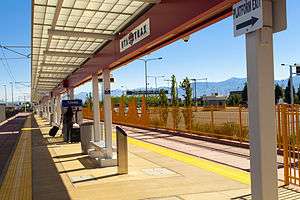
A line from Salt Lake City International Airport to the University of Utah was in the original plans for the system to be completed before the 2002 Winter Olympics, but funding shortages only allowed the eastern portion to be constructed. The airport line eventually came to fruition, however, and ground was broken on October 22, 2008.[23] The extension opened on April 14, 2013,[24] adding 6 miles (9.7 km)[5] and six additional stations to the Green Line, including a transfer station to the FrontRunner.
Draper extension
On November 14, 2006, the Draper City Council approved the TRAX extension into that city.[25] Neighbors in the area have continually fought the route suggested by UTA. The route follows an old rail line and UTA already owned the right of way. An alternative route that would run down the middle of State Street was also studied by UTA.[26] Use of the UTA right of way for the line was challenged in court and later approved by the Utah Supreme Court on July 12, 2008.[27] UTA published a draft Environmental Impact Statement for the new line that names the UTA right of way as the preferred route. The extension's first phase, which includes 3.5 miles (5.6 km) and three new stations, opened on August 18, 2013.[28] A second phase will extend the line further south to 14600 South (near I-15, Exit 288), but the UTA has not announced the dates for the construction and completion of this further extension.
The FrontRunner
When the FrontRunner (UTA's commuter rail train) started running on April 26, 2008, the only transfer station between the FrontRunner and TRAX was Salt Lake Central (Salt Lake Intermodal Hub), with the FrontRunner running north from that station to Ogden. However, with the opening of the FrontRunner South extension on December 10, 2012,[29] with service south to Provo, Murray Central was added as second transfer station which allowed for transfer to the Blue and Red lines. Although not part of the FrontRunner South extension, FrontRunner service at the new North Temple Bridge/Guadalupe station also began on the same day. When the Airport extension of the Green Line opened for service on April 14, 2013, this station became the third transfer station between FrontRunner and TRAX. The FrontRunner portion of this station was built to provide a transfer station between FrontRunner and the Green Line, since the reroute of the Green Line for the Airport extension would have left the Green Line without any common station with FrontRunner.
S Line
For several years a TRAX spur into the Salt Lake City neighborhood of Sugar House had been contemplated. A series of community meetings were held in Sugar House as part of a larger transit study undertaken by UTA. Several transit alternatives were presented to the neighborhood, including bus rapid transit, light rail, and a streetcar.[30] The streetcar seemed to be the preferred alternative.[31] On October 20, 2010, the S Line (known then as Sugar House Streetcar) received a $26 million federal grant that allowed the street car to be completed in less than two years.[32] It used an existing rail line running along 2200 South from the Central Pointe TRAX Station to approximately 1100 East, near the primary Sugar House shopping district. The first phase of the S Line opened on December 8, 2013.[33][34]
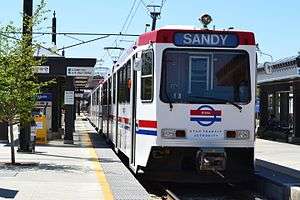
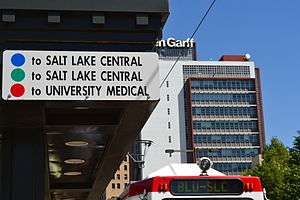
Planned expansion projects
UTA has ordered a Draft Environment Study Report for transit alternatives in southern Davis County, including more comprehensive bus service, streetcar lines, and a TRAX line.[35] Some residents opposed UTA's proposal to bring light rail to southern Davis County.[36] In conjunction with the Mountain View Corridor project, there are also plans to build a TRAX line on the west side of the Salt Lake Valley along 5600 West (in the same general area as the Mountain View Corridor).[37] The western line is anticipated to replace the yet-to-be-built 5600 West MAX bus rapid transit (BRT) line.
Following the completion of the FrontLines 2015 project, UTA has stated they intend to focus on lower-cost projects such as streetcars and bus rapid transit. However, they do intend to extend main TRAX lines. In addition to the aforementioned expansions, they also plan to extend the Blue Line from Draper to Lehi and eventually Orem. They are also exploring the possibility of mass transit to the ski resorts and Park City.[38]
Commercial advertising restrictions
UTA does not sell naming rights for its stations, nor does it allow stations to be named after commercial businesses. Commercial advertising on TRAX platforms is prohibited, in order for the passengers to be able to notice the safety information.[39] One exception to this rule occurred during the 2002 Winter Olympics. Since, for security reasons, the Arena and Temple Square stations were closed, UTA allowed Coca-Cola to use the area of the unused Arena Station as part of its pin-trading center.[40] The advertising restriction does not apply to the sides of the TRAX train cars or to UTA's buses. Not only does UTA have advertising signs on the sides and rear of many of its buses, it also has many buses where the painting scheme of the full rear or even the entire bus is an advertisement (bus wrap).[41]
See also
- Utah Transit Authority
- Transportation in Salt Lake City
- FrontRunner – commuter rail system
- S Line (formerly known as Sugar House Streetcar)
- List of tram and light rail transit systems
Notes
- Data for THIRD quarter 2000, no ridership data reported by American Public Transportation Association (APTA) for UTA for fourth quarter
- Red Line (University extension) opened in December 2001
- Red Line (University Medical Center extension) opened in September 2003
- The FrontRunner opened in April 2008
- Red Line Mid-Jordan extension and Green Line West Valley extension both opened in August 2011
- The FrontRunner South extension opened in December 2012
- Green Line Airport extension opened in April 2013, Blue Line Draper extension opened in August 2013, and S Line opened in December 2013
- Ridership data for 2014 and beyond also includes UTA's streetcar operations
- Ridership data for 2014 and beyond also includes UTA's streetcar operations
- Ridership data for 2014 and beyond also includes UTA's streetcar operations
References
General
- "Customer Service Locations". Utah Transit Authority. Retrieved March 6, 2013.
- "About UTA". rideuta.com. Utah Transit Authority. Retrieved August 6, 2014.
- "UTA Fleet: Trax and FrontRunner" (PDF). rideuta.com. Utah Transit Authority. August 2008. Archived from the original (PDF) on February 15, 2012. Retrieved February 11, 2012.
- "Siemens announces biggest US light rail order". Railway Gazette International. May 15, 2008. Archived from the original on June 16, 2011. Retrieved May 16, 2008.
- "FrontLines 2015 Project" (PDF) (Map). rideuta.com. Utah Transit Authority. Archived from the original (PDF) on June 23, 2013. Retrieved March 5, 2013.
- "UTA TRAX LightRail". utahrails.net. Utah Rails. January 6, 2007. Retrieved August 19, 2007.
- "UTA Announces FrontRunner Grand Opening Date!". rideuta.com (Press release). Utah Transit Authority. Retrieved January 10, 2013.
- "Fixed Route Accessibility". rideuta.com. Utah Transit Authority. Retrieved March 13, 2013.
- "Rider Rules". rideuta.com. Utah Transit Authority. Retrieved March 12, 2013.
- "TRAX" (PDF). rideuta.com. Utah Transit Authority. December 8, 2013. Archived from the original (PDF) on November 25, 2013. Retrieved February 10, 2014.
- Davidson, Lee (August 2, 2011). "TRAX lines opening a year early, 20% under budget". The Salt Lake Tribune. Salt Lake City: MediaNews Group. Retrieved August 3, 2011.
- "UTA setting end dates on TRAX construction". Deseret News. Salt Lake City: Deseret Digital Media. August 9, 2007. Retrieved June 2, 2008.
- Warburton, Nicole (December 29, 2006). "Tax to build 3 rail lines, fix highway". Deseret News. Salt Lake City: Deseret Digital Media. Retrieved June 3, 2008.
- Warburton, Nicole (September 25, 2007). "UTA on track for U.S. funds". Deseret News. Salt Lake City: Deseret Digital Media. Retrieved June 3, 2008.
- Warburton, Nicole (January 27, 2008). "New method of counting shows 'decline' in TRAX ridership". Deseret News. Salt Lake City: Deseret Digital Media. Retrieved February 16, 2008.
- "$5 million OK'd for light rail". Deseret News. Salt Lake City: Deseret Digital Media. United Press International. October 10, 1988. Retrieved March 5, 2013.
- Fattah, Geoffrey (September 30, 2003). "UTA extends TRAX line to U. med center". Deseret News. Salt Lake City: Deseret Digital Media. Retrieved March 4, 2013.
- "UTA trustees OK nearly $239M budget". The Salt Lake Tribune. Salt Lake City: MediaNews Group. The Associated Press. December 14, 2006. Retrieved December 17, 2006.
- "UTA Projects/Programs > Salt Lake Intermodal Hub TRAX Extension". rideuta.com. Utah Transit Authority. Archived from the original on April 15, 2008.
- http://utahrails.net/utahrails/savage-bingham-garfield.php
- Warburton, Nicole; Dethman, Leigh (December 21, 2006). "Tax to build 3 rail lines, fix highway". Deseret Morning News. Salt Lake City: Deseret Digital Media. Retrieved January 1, 2007.
- Davidson, Lee (December 13, 2012). "New TRAX lines still short of ridership projections". The Salt Lake Tribune. Salt Lake City: MediaNews Group. Retrieved March 7, 2013.
- Hancock, Laura (October 22, 2008). "UTA breaking ground today for airport TRAX line". Deseret News. Salt Lake City: Deseret Digital Media. Retrieved June 28, 2009.
- "UTA FrontLines 2015: Airport Line" (PDF). rideuta.com. Utah Transit Authority. Retrieved January 4, 2013.
- Nielson-Stowell, Amelia (November 15, 2006). "Draper approves TRAX route". Deseret News. Salt Lake City: Deseret Digital Media. Retrieved December 17, 2006.
- "Draper Transit Corridor Project: Alternatives Considered" (PDF). rideuta.com. Utah Transit Authority. Retrieved January 4, 2013.
- "Court says Draper TRAX route OK". ksl.com. Salt Lake City: Deseret Digital Media. Associated Press. July 12, 2008. Retrieved July 12, 2008.
- Reavy, Paul (June 4, 2013). "State, city and school officials stress safety on new Sandy-Draper TRAX line". Deseret News. Salt Lake City: Deseret Digital Media. Retrieved June 26, 2013.
- Park, Shara (December 10, 2012). "FrontRunner South opens, brings changes to north line". ksl.com. Salt Lake City: Deseret Digital Media. Retrieved December 12, 2012.
- "Sugar House Transit Corridor - Alternatives Analysis- FINAL REPORT" (PDF). rideuta.com. Utah Transit Authority. July 2008. Retrieved August 17, 2013.
- "Sugar House Transit Corridor Alternatives Analysis Open House Summary" (PDF). utabus.com. Utah Transit Authority. Retrieved January 4, 2013.
- Page, Jared (October 20, 2010). "Salt Lake City receives $26 million for Sugar House streetcar project". Deseret News. Salt Lake City: Deseret Digital Media. Retrieved October 20, 2010.
- Vo-Duc, Viviane (September 5, 2013). "New streetcar S-line set to open Dec. 8 in Sugar House". Deseret News. Salt Lake City: Deseret Digital Media. Retrieved September 17, 2013.
- "Sugar House Streetcar: Project Updates". shstreetcar.com. Retrieved March 4, 2013.
- "South Davis Transit Study". rideuta.com. Utah Transit Authority. Retrieved August 17, 2013.
- Dougherty, Joseph M. (March 29, 2010). "Coalition to rally tonight against South Davis light rail". Deseret News. Salt Lake City: Deseret Digital Media. Retrieved January 10, 2013.
- "Mountain View Corridor Environmental Impact Statement" (PDF). udot.utah.gov. Utah Department of Transportation. Retrieved January 4, 2013.
- Davidson, Lee (February 11, 2013). "What's next at UTA? More frequent service, and yet more building". Salt Lake Tribune. Salt Lake City: MediaNews Group. Retrieved March 10, 2013.
- Henetz, Patty (November 22, 2006). "TRAX changes signs on northbound trains". The Salt Lake Tribune. Salt Lake City: MediaNews Group. Retrieved August 5, 2013.
- "Coca-Cola to use TRAX station". Deseret News. Salt Lake City: Deseret Digital Media. January 25, 2002. Retrieved August 5, 2013.
- Stagg, Jennifer (October 13, 2010). "Controversial ads draw attention on UTA buses". ksl.com. Salt Lake City: Deseret Digital Media. Retrieved August 5, 2013.
APTA Statistics
- "Public Transportation Ridership Report Fourth Quarter 2015" (PDF). www.apta.com. American Public Transportation Association. March 2, 2016. p. 29. Retrieved July 14, 2016.
- "Transit Ridership Report Fourth Quarter 1999" (PDF). American Public Transit Association. April 18, 2000. p. 26. Retrieved March 16, 2013.
- "Transit Ridership Report Third Quarter 2000" (PDF). American Public Transportation Association. December 29, 2000. p. 26. Retrieved March 16, 2013.
- "Transit Ridership Report Fourth Quarter 2001" (PDF). www.apta.com. American Public Transportation Association. April 12, 2002. p. 28. Retrieved March 16, 2013.
- "Transit Ridership Report Fourth Quarter 2002" (PDF). www.apta.com. American Public Transportation Association. April 24, 2003. p. 32. Retrieved March 16, 2013.
- "Transit Ridership Report Fourth Quarter 2003" (PDF). www.apta.com. American Public Transportation Association. August 3, 2004. p. 31. Retrieved March 16, 2013.
- "Transit Ridership Report Fourth Quarter 2004" (PDF). www.apta.com. American Public Transportation Association. March 15, 2005. p. 32. Retrieved March 16, 2013.
- "Transit Ridership Report Fourth Quarter 2005" (PDF). www.apta.com. American Public Transportation Association. April 4, 2006. p. 28. Retrieved March 16, 2013.
- "Public Transportation Ridership Report Fourth Quarter 2006" (PDF). www.apta.com. American Public Transportation Association. March 12, 2007. p. 28. Retrieved March 16, 2013.
- "Public Transportation Ridership Report Fourth Quarter 2007" (PDF). www.apta.com. American Public Transportation Association. March 5, 2008. p. 33. Retrieved March 16, 2013.
- "Public Transportation Ridership Report Fourth Quarter 2008" (PDF). www.apta.com. American Public Transportation Association. March 5, 2009. p. 30. Retrieved March 16, 2013.
- "Public Transportation Ridership Report Fourth Quarter 2009" (PDF). www.apta.com. American Public Transportation Association. March 2, 2010. p. 29. Retrieved March 16, 2013.
- "Public Transportation Ridership Report Fourth Quarter 2010" (PDF). www.apta.com. American Public Transportation Association. March 8, 2011. p. 28. Retrieved March 16, 2013.
- "Public Transportation Ridership Report Fourth Quarter 2011" (PDF). www.apta.com. American Public Transportation Association. February 24, 2012. p. 27. Retrieved March 16, 2013.
- "Public Transportation Ridership Report Fourth Quarter 2012" (PDF). www.apta.com. American Public Transportation Association. March 1, 2013. p. 27. Retrieved March 16, 2013.
- "Public Transportation Ridership Report Fourth Quarter 2013" (PDF). www.apta.com. American Public Transportation Association. February 26, 2014. p. 28. Retrieved March 11, 2014.
- "Public Transportation Ridership Report Fourth Quarter 2014" (PDF). www.apta.com. American Public Transportation Association. March 3, 2015. p. 29. Retrieved September 15, 2015.
- "Public Transportation Ridership Report Fourth Quarter 2016" (PDF). www.apta.com. American Public Transportation Association. March 2, 2016. p. 29. Retrieved July 14, 2016.
External links
| Wikimedia Commons has media related to |
- Utah Transit Authority official website
- TRAX official website
- Utah Rails, timeline of UTA Trax project
